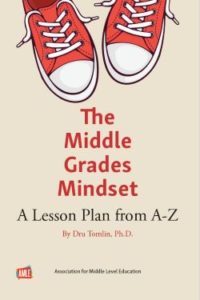A Deep Look into the Middle Grades Mindset
The Middle Grades Mindset: A Lesson Plan from A – Z
By Dru Tomlin
(AMLE, 2021 – Learn more)
Reviewed by Cheryl Mizerny

Full disclosure: Dru is a friend and colleague and I have worked with him through the Association for Middle Level Education, where he led the professional services program for nearly five years before returning to his first love: middle school principal.
I know him to be a dynamic, dedicated, honest, effective educator. He’s whip-smart and the master of the extended metaphor. A wise person to listen to.
A good read if you’re ready for renewal
My professional philosophy aligns with his, and I hoped his beliefs would translate to the page when I read the book, and it did not disappoint.

Anger: Tomlin stresses that adolescents have anger issues they cannot always handle on their own. This is an opinion not often expressed in education books and I appreciated it. He also shares his experiences helping adolescents channel and redirect their anger rather than stigmatizing them for it.
Construction: As an educator who takes a constructionist approach, I enjoyed this chapter. Dru has a fun way of expressing this education style: YBYS + IBMS = WLMST (You Bring Your Stuff and I’ll Bring My Stuff and We’ll Learn More Stuff Together). This is a good refresher discussion, reminding us that the classroom does not belong solely to the teacher.
Discipline: In this chapter Dr. Dru reminds us that nurturing relationships and “seeing” students outside of our class are the best proactive solutions to discipline problems. He describes how important it is for administrators and teachers to be in the common spaces during transitions each day, “taking in information, listening to students’ chatter, seeing their body language, moving to key areas, being available, and asking questions if you sense an issue.” In my own career I’ve found this to be true. I find out so much more by observing and interacting outside of class than I do for the 45 minutes a day a student is in front of me.
Exceptional: As a former special education teacher, this chapter was near and dear to my heart. I found myself nodding and smiling when I read, “When we separate students based on their measured intellectual prowess and provide only those ‘advanced’ students with more challenging learning activities . . . we are doing ourselves, education, and all students a disservice.” I have long advocated for this and usually meet resistance. It was refreshing to see an administrator support the same ideas.
Inclusive: Another area in which Dru and I align is our belief that good middle schools are inclusive. It is not only academic and athletic stars that shine in a healthy school – everyone finds their place to belong. He encourages schools to examine their advisory programs to ensure that this inclusivity is happening.
Keep: After the challenges that Covid has presented to schools in this country, I appreciated Tomlin’s acknowledgement of the desire among both teachers and students to sometimes just keep things the same for a little while. It seems as if there is an imperative among administrators to implement the hot new thing on an annual basis and pursue change for change’s sake. This is mentally exhausting for all involved. He does encourage educators to continue to improve, and to become the best version of ourselves.
Numbers: Dr. Dru reminds us that grades should not be used punitively nor to label a student. He knows that when there is no hope left to pass a class, there is also no way to motivate a student.
Questions: I believe in the power of deep questions and the need to foster an inquiry culture. In this chapter, Tomlin provides a brilliant list of nine simple steps to build a culture of inquiry in our classrooms. These include suggestions such as modeling curiosity and implementing genius hour.
Read an article by Dru Tomlin here at MiddleWeb
“Adolescents Thrive on Advocacy and Agency”
Relationships: No book about teaching in the middle grades would be complete without the mention of relationships because they are at the heart of what we do. Dr. Dru says, “Be. There. Every. Day. When you can understand, value, and relate to your students’ worlds, you will be more insightful, more ready, and more able to make learning more relevant for them.” Yes!
Xenophobia: In this chapter, Tomlin reminds us not to celebrate other cultures in a tokenizing way, but rather to celebrate every student’s culture throughout the year and to recognize that every family has its own culture even if they are not from another country. This is important.
Zen and the Art of Mulching: This chapter shows Dru’s expertise with an extended metaphor. He relates facts about the benefits of mulch to implications for our school success. For example, we know that “Mulch can beautify your garden.” School pride and celebration is the mulch we use to keep our school vibrant and productive month after month and year after year.
Although I have the honor of calling Dru Tomlin a colleague and friend, our connection was not a prerequisite for enjoying this book. Whether this is your second year or twenty-second year in education, you will find something that confirms your “why” of teaching middle school – and you may even pick up a tip or two.
Cheryl Mizerny (@cherylteaches) is a veteran educator with 25 years experience – most at the middle school level. She began her career in special education, became a teacher consultant and adjunct professor of Educational Psychology, and currently teaches 6th grade English in Bloomfield Hills, Michigan. Read her rich collection of MiddleWeb articles here.


































